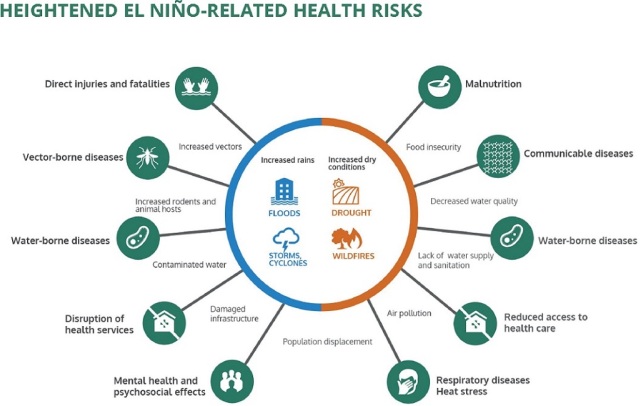
According to a new WHO report, severe drought, flooding, rains and
temperature rises are all known effects of El Niño that can lead to food
insecurity, malnutrition, disease outbreaks, acute water shortages and
disruption of health services. El Niño is a warming of the central to eastern
tropical Pacific Ocean which affects rainfall patterns and temperatures in many
parts of the world but most intensely in the tropical regions of Africa,
Asia-Pacific, and Latin America which are particularly vulnerable to natural
hazards. Typically, some places receive much more rain than normal while others
receive none.
The health implications are usually more intense in developing
countries with fewer capacities to reduce the health consequences. The current
El Niño from 2015 to 2016 is predicted to be the worst in recent years and
comparable to the El Niño in 1997-1998 which had major health consequences
worldwide. In Eastern Africa, as a result of the El Niño in 1997-1998, WHO
found that rainfall patterns were unusually heavy and led to serious flooding
and major outbreaks of malaria, cholera and Rift Valley Fever.
WHO’s report notes that important steps can be taken to prevent
and reduce the health effects of El Niño, including: disease surveillance;
controlling the transmission of diseases (e.g. vaccinations) and the vectors
that spread diseases; mobilizing communities to promote health and hygiene
practices; improving water and sanitation services; strengthening logistics and
medical supply chains; providing emergency medical care and maintaining access
to health services; and effective coordination of preparedness and response
measures.
WHO
and partners are working closely to support governments and the health sector
in their preparedness and response for El Niño. To support national emergency
measures in many countries, WHO has deployed specialized health emergency and
technical personnel to Ethiopia, Indonesia, Papua New Guinea, Somalia, Tanzania
and several Pacific Islands. WHO and health sector partners have provided
inputs to government and UN interagency planning and coordination for El Niño
at national level, including in Ecuador, Haiti, Kenya, Malawi, Papua New
Guinea, Somalia, Sudan and Uganda.
In
addition, WHO has actively worked with countries and donors in other ways,
including, information management and health risk assessments, as well as
engagement with national meteorological agencies for detailed updates on
rainfall observed as well as more localized predictions.
Dr. Shima Naghavi, Director of International Affairs